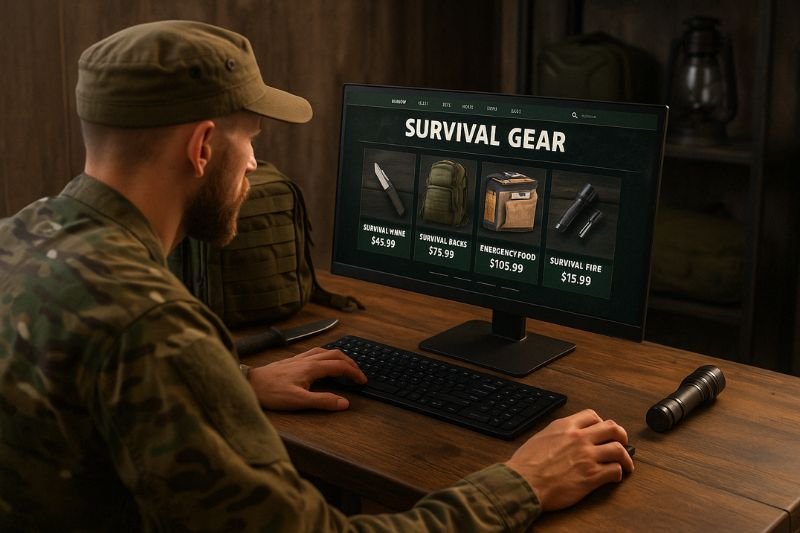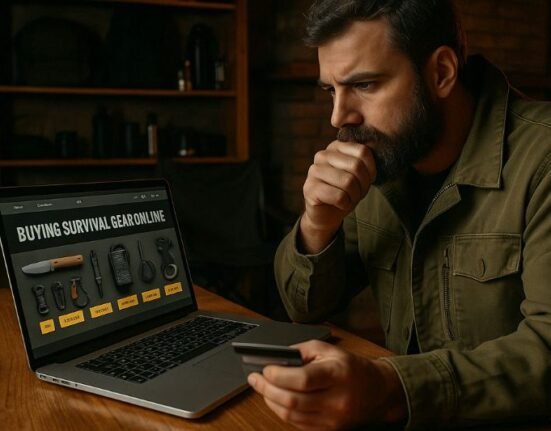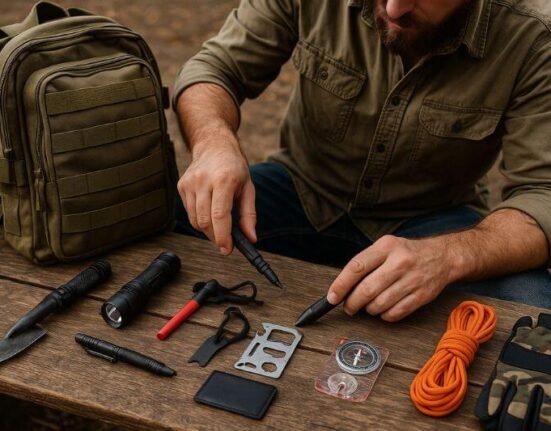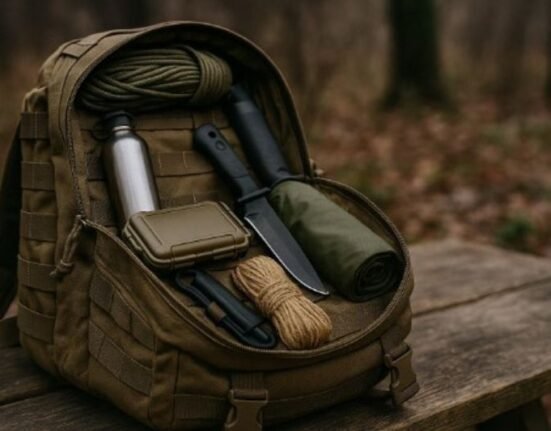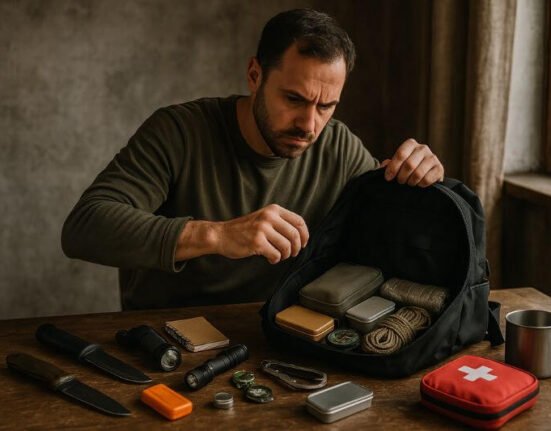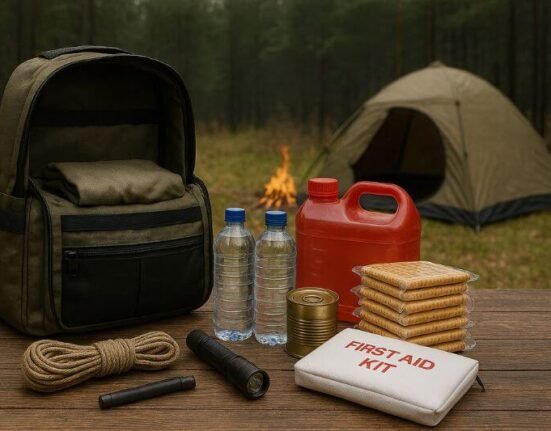In recent years, sales of popular survival gear have skyrocketed online. From basic bug-out items to advanced multi-purpose tools, preppers are filling digital carts with gear designed to help them face everything from blackouts to full-blown societal collapse.
But what do they actually buy—when no brands are pushed, no influencers are paid, and no ads are telling them what to click?
This article cuts through the marketing noise to explore the real trends in prepper buying behavior. You’ll discover:
- The most commonly purchased survival gear categories
- What that gear reveals about evolving prepper priorities
- And why understanding what preppers actually buy can help you build a smarter, leaner kit—without wasting money or falling for hype
No brand names. No sales links. Just pure survival insight, based on what’s moving through online marketplaces.
🟦 Why Survival Gear Sales Are Surging Online
🌐 The Rise of Online Preparedness
Online shopping has made survival gear more accessible than ever. Preppers—urban and rural alike—now turn to e-commerce platforms not only for price comparison, but for gear availability, user reviews, and fast shipping during unstable times.
A few key reasons behind the trend:
- Brick-and-mortar stores often lack specialized gear
- Discreet delivery appeals to privacy-focused individuals
- Online bundles allow for fast “grab-and-go” readiness
- Stockpiling is easier and more scalable via online orders
What once required visiting multiple stores and military surplus suppliers can now be done from a laptop in one sitting.
⚠️ Pandemic, Conflict, and Collapse: Drivers Behind the Trend
Since 2020, preppers have witnessed:
- Global pandemics
- Supply chain breakdowns
- Political unrest
- Technological disruptions
- Climate-related disasters
Each of these events caused online gear sales to spike—often within hours of breaking news.
For example:
- Portable water filters sold out after municipal contamination reports
- Long-term food kits disappeared during lockdowns
- Solar-powered radios surged after major blackouts
📈 Real-time fear translates to real-time purchases—and online platforms allow instant response.
🔍 What Makes a Product “Popular” Among Preppers?
Popularity in the prepper world isn’t based on advertising—it’s based on function.
Preppers tend to favor gear that is:
- Multi-purpose (e.g., a tarp that becomes shelter, water catch, or stretcher)
- Lightweight and compact
- Durable in harsh environments
- Compatible with existing kits (modular)
- Field-tested by real users (not lab marketing)
While some gear is flashy or overhyped, the items that consistently sell online among preppers are those that solve problems reliably—without gimmicks.
Top Categories of Popular Survival Gear
Understanding what categories of gear preppers buy the most helps reveal their real survival priorities. This isn’t about endorsements or flashy marketing—it’s about what consistently shows up in bug-out bags, go-kits, and off-grid shelters.
Below are the six categories of popular survival gear that frequently top the charts across online marketplaces, forums, and prepper inventories.
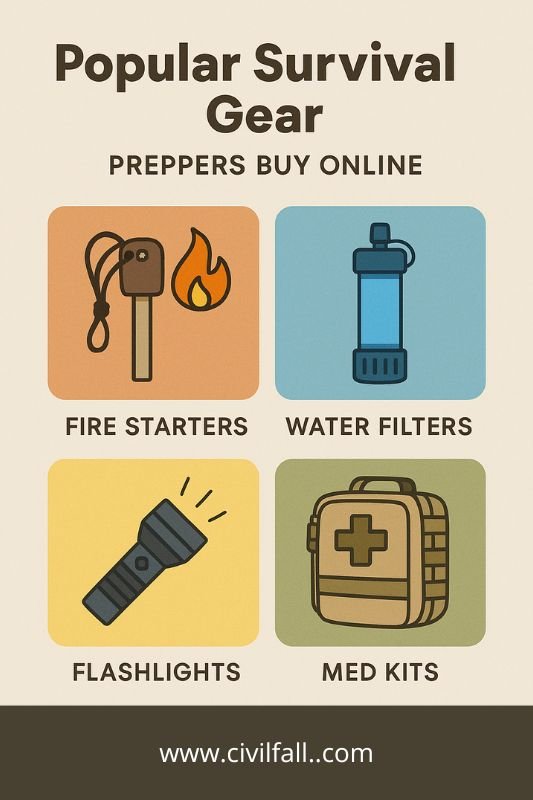
💧 Water Filtration Systems
Water is life—but only if it’s clean. It’s no surprise that portable water filters, gravity-fed systems, and chemical purification tablets are among the most purchased survival items online.
Most popular types:
- Compact straw-style filters for EDC and bug-outs
- Pump filters for mobile group survival
- Gravity systems for basecamps and long-term use
- Chemical tablets or drops as lightweight backups
✅ Why preppers buy it:
- Water is heavy to carry, but easy to filter
- Natural water sources are unpredictable post-disaster
- Filtration gear offers autonomy and movement
🧠 Insight: This category shows that preppers prioritize mobility + hydration, especially for rapid evacuation scenarios.
🍲 Emergency Food and Cooking Gear
Preppers consistently stock up on shelf-stable food and compact cooking equipment. But rather than brand-focused choices, they go for shelf life, calorie density, and ease of use.
Key items in this category:
- Freeze-dried meals in Mylar bags
- Emergency food bars (high-calorie, compact)
- Collapsible stoves (alcohol, wood-burning, solid fuel)
- Titanium sporks, mess kits, and pot stands
- Windproof lighters or fire cubes for cooking ignition
✅ Why preppers buy it:
- No prep = no calories = no energy
- Power outages make standard kitchens useless
- Heat + food = morale + survival
🧠 Insight: Food security is psychological—this gear offers control when everything else feels chaotic.
🛖 Shelter and Warmth Essentials
Preppers expect exposure. Whether escaping a disaster zone or hunkering down in a vehicle, shelter gear sells consistently.
Most common gear bought:
- Emergency bivvies and survival blankets
- Lightweight tarps with grommets or loops
- Foldable ground pads and reflective liners
- Compact tents or hammock shelters
- Thermal clothing inserts and hand warmers
✅ Why preppers buy it:
- Shelter can’t wait. You need it fast, dry, and functional.
- Improvised shelters take skill and time.
- Hypothermia is a threat in any season if soaked or underfed.
🧠 Insight: Popularity in this category shows that preppers plan for long waits, not fast rescues.
🔥 Fire Starters and Lighting Tools
No survival kit is complete without fire and light. Preppers regularly stock multiple ignition tools, often in layers (EDC, bug-out, camp).
Items that move fast online:
- Waterproof matches and refillable lighters
- Ferro rods with striker cords
- Tinder cubes or fire paste
- Compact LED flashlights and headlamps
- Solar lanterns or crank-powered lights
✅ Why preppers buy it:
- Fire provides heat, light, sterilization, morale
- Light helps with navigation, tasks, and security
- Redundancy = peace of mind
🧠 Insight: Gear that creates fire and light is universally trusted—and that trust drives repeat purchases.
🗡️ EDC and Tactical Tools
Everyday carry tools are some of the most popular survival gear, not because they’re flashy—but because they work.
Popular EDC gear types:
- Folding knives and multitools
- Compact pry bars or mini hatchets
- Paracord bracelets with built-in tools
- Tactical pens with glass breakers
- Lightweight utility pouches
✅ Why preppers buy it:
- Portability and daily usability
- Quick access to critical tools
- Self-defense, shelter-building, and general repairs
🧠 Insight: Preppers aren’t just buying tools—they’re buying control in moments of crisis.
🩹 First Aid and Trauma Kits
This category isn’t glamorous, but it’s essential. Preppers often build or supplement their own kits from components, based on actual risk—not marketing.
Commonly bought items:
- Trauma shears, tourniquets, hemostatic gauze
- Burn dressings, splints, and antiseptic sprays
- Allergy meds, painkillers, and antibiotics
- Dental kits and suturing tools
- Refillable pouches with MOLLE attachment
✅ Why preppers buy it:
- Help may never come
- Most first aid kits are too basic
- “Self-reliant medicine” is a prepper mantra
🧠 Insight: Consistent sales here reflect one truth: gear that saves lives quietly is always in demand.
🧭 Final Observation:
The categories above show that popular survival gear online isn’t about hype—it’s about function, redundancy, and trust. These items keep showing up in prepper carts for one reason: they solve real-world survival problems in every context, from bug-outs to blackouts.
What Prepper Demand Tells Us About Modern Survival Priorities
Survival gear sales aren’t random. They reveal patterns—what people fear, what they value, and how they expect the world to break. When you analyze what preppers consistently buy online, a few strong themes emerge.
This section explores how these habits reflect evolving priorities, shaped by crisis after crisis.
🧰 Trends in Lightweight and Multi-Use Tools
Preppers increasingly favor gear that does more with less. Why?
Because mobility matters. Whether fleeing wildfires, navigating urban collapse, or bugging out on foot, weight kills.
Common features now prioritized:
- Dual-use: flashlight + solar charger
- Compact formats: folding saws, collapsible cups
- Stackable systems: nesting cook kits, roll-up blankets
- Storage inside gear (knife sheaths with ferro rods, flashlight handles with tinder)
🧠 Takeaway: Modern preppers prefer modular gear that adapts, not single-use gimmicks.
🔄 Modular and Redundant Gear Systems
A shift is happening—from standalone tools to layered systems.
Instead of buying “a firestarter,” preppers now build systems:
- Ferro rod + stormproof matches + plasma lighter
- Filter straw + pump filter + purification tablets
- Bivvy sack + tarp + mylar blanket
Why redundancy?
- Because real survival is dirty, unpredictable, and failure-prone
- Because redundancy is reliability—when gear breaks or gets lost
🧠 Takeaway: Buying behavior shows a systems mindset, not just a checklist.
🌆 Urban vs Rural Gear Priorities
Online data reveals interesting differences in gear choices based on environment:
| Environment | Trending Gear | Reason |
|---|---|---|
| Urban | Folding tools, masks, water filters | Focus on stealth, mobility, contamination |
| Rural | Axes, water catchment, bulk food | Focus on self-reliance, extended shelter |
🧠 Insight: Urban preppers expect fast chaos. Rural preppers plan for slow collapse.
This shapes what they buy—and how they pack it.
🛑 The Influence of Online Reviews (and Why They Mislead)
Ironically, many prepper purchases are shaped by mainstream review patterns—not experience.
Problems with online reviews:
- Often based on unboxing, not field use
- Upvoted by aesthetics, not function
- Influence herd mentality: “most popular” ≠ most reliable
- Fake reviews from sellers or bots muddy the data
More experienced preppers tend to:
- Cross-reference real-world forums (e.g., Reddit, Bushcraft USA)
- Trust long-term field tests and side-by-side comparisons
- Avoid 5-star-only listings with generic feedback
🧠 Takeaway: Not all “popular survival gear” is actually effective—but the demand patterns still reveal valuable intent.
✅ Conclusion of the section:
Prepper behavior in online markets reflects a growing maturity in the survival community. The trend is shifting toward multi-purpose, modular, and redundancy-based planning, away from flashy, one-use items.
The purchases may differ—but the priority is clear: gear that works when the world doesn’t.
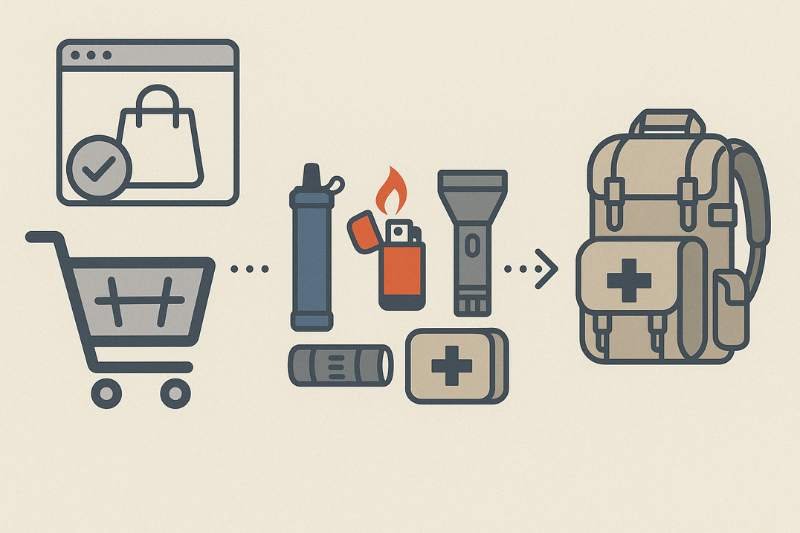
❓ Frequently Asked Questions (FAQ) – Popular Survival Gear
🧭 Why do most preppers avoid branded gear recommendations?
Seasoned preppers tend to avoid brand-specific suggestions for one main reason: brands change, but function doesn’t.
While some companies have built reputations in the preparedness community, the most experienced preppers focus on:
- Specifications over logos
- Durability and performance in the field
- Compatibility with their current setup
- Reviews from real-world use, not sponsored “top 10” lists
They also understand that:
- A product’s popularity doesn’t always equal quality
- Supply chains fluctuate—brand loyalty can trap you
- Survival isn’t about status—it’s about resilience
🧠 In short, preppers buy based on mission and utility, not marketing.
📈 What survival items sell most during crises?
Each crisis triggers a different wave of gear demand—but some categories almost always spike first:
| Crisis Type | Survival Items That Sell Fast |
|---|---|
| Natural disaster | Water filters, radios, lighting tools |
| Political unrest | Tactical bags, knives, trauma kits |
| Pandemic or lockdown | Shelf-stable food, sanitation kits |
| Grid-down or blackout | Solar panels, crank radios, fire gear |
| Evacuation scenarios | Bug-out bags, shelter systems, maps |
These patterns reveal that preppers respond fast to news, often outpacing supply. The result?
Products sell out, prices spike, and shipping delays occur.
🧠 That’s why many preppers maintain a ready-stocked “baseline” kit, updated as crises evolve.
🧪 Are bestsellers always reliable?
Not necessarily.
A product being labeled a “bestseller” on Amazon or elsewhere doesn’t mean it’s the best choice for survival. In fact, many bestsellers are:
- Inexpensive entry-level gear
- Purchased by casual campers or first-time preppers
- Optimized for visibility, not longevity
- Mass-reviewed but poorly tested in real conditions
Experienced preppers often discover that:
- Some of the most popular items fail under pressure
- Lower-profile gear performs better but receives fewer reviews
- The more critical the tool (e.g., fire, water, shelter), the more careful the selection should be
🧠 Use bestsellers as a starting point, not a final decision.
❓ How can I tell if gear is actually prepper-approved?
There’s no certification stamp—but there are clear indicators that gear is prepper-vetted:
Look for:
- Field-tested reviews from survival forums, YouTube demos, or crisis replays
- Mentions in multiple prepper platforms, not just blogs or sales pages
- Compatibility with core gear principles: lightweight, redundant, multi-use, and durable
- Modifications in the wild—if people are customizing it, they’re probably using it hard
- Absence of gimmicks—real gear tends to be ugly, simple, and overbuilt
Bonus tip: Preppers often favor gear that disappears from shelves during a real emergency. If an item consistently vanishes during crises, it’s likely trusted.
🧠 The golden rule: Trust performance, not packaging.









